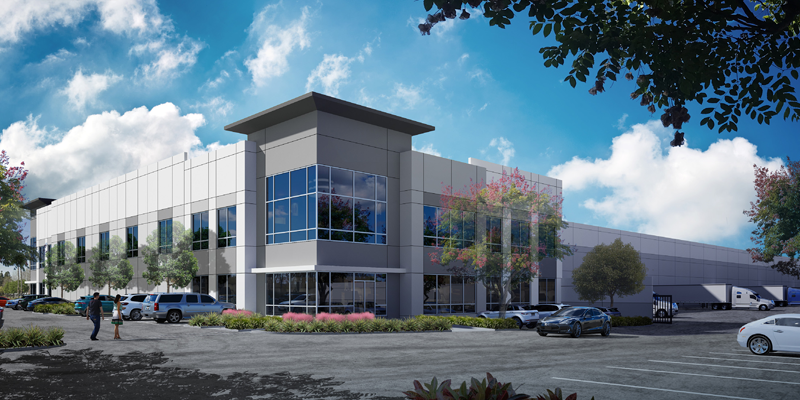Movement is key in the SoCal industrial space. Industrial real estate occupies some 200 million square feet of space in the SoCal region, with much of the activity driven by the Ports of L.A. and Long Beach. The swift movement – not storage – of goods from the port to their destinations, is priority. Currently, the industrial vacancy rate sits at 4%. While the increase in e-commerce during the COVID-19 pandemic caused industrial volume in the region to surge, volumes have declined 30% over the past year, returning to more normal, though still high, levels comparable to 2019.
Attendees of I.CON West in Long Beach, California, had the opportunity to visit three impressive industrial properties in the SoCal region. The projects by Goodman, Watson Land Company and Bridge Industrial are in three different phases of completion and range in size from 165,000-500,000 square feet.
The I.CON West group toured a 90-acre site in Long Beach purchased by Goodman, a globally traded real estate company, five years ago. The Goodman Commerce Center Long Beach was previously a Boeing manufacturing center with 100-foot clear heights that made it well suited for the current tenant: Relativity, a company that makes 3-D printed rockets.
Power is a major consideration for tenants in the region. Tenants are also asking for clear heights that are increasingly taller; the typical height in 2012 was 32 feet, but industrial buildings in the area are inching closer to the 40-foot range as the standard.
Environmental concerns are top of mind in California. Long Beach requires a methane mitigation system and Boeing also required a vapor barrier to be added to the site as part of their land use covenant. The area was previously heavily comprised of oil fields, so vapor barriers are common. The state is working toward a 2035 goal of having 100% of new cars and light trucks sold in California be zero-emission vehicles, so sites are considering the current usage and future expansion of EV charging stations. Goodman’s site is equipped with 26 EV-charging stations but has the capability to expand to 100 more, as needs require.
Watson Land Company’s site in Carson, California, is located in the South Bay, an area that includes many 1980s-era Class B buildings that are being redeveloped to meet modern usage and demand.
One of the main challenges faced in this area is the heavy clay soil; Watson had to install an underground storm drain system to allow for percolation.
One of the main advantages of the area is that it’s within the “Overweight Container Corridor” that allows for heavier vehicles – up to 95,000 pounds – to pass through with containers from the port.
Watson Land Company is pursuing U.S. Green Building Council LEED Gold certification for this site; they were able to reuse or recycle 98.6% of the material crushed from the previous buildings. The company aims for LEED Silver or Gold in many of their buildings in California, part of its early legacy dating to the founding of Watson Land Company in 1912 with a commitment to serve as “good stewards of the land.”
Another feature of the Watson Land Company’s building: ample skylights – a 3% skylight to roof ratio – and clerestory windows to bring in maximum natural light.
For the final stop of the tour, attendees visited a former brownfield site in Torrance, California, developed by Bridge Industrial. Bridge Industrial considers its team problem solvers who can tackle sites like this one that require significant remediation. They have transformed the brownfield site into a modern, airy industrial facility with two stories of office space.
Power, again, came up as a critical concern for tenants. Bridge Industrial used to provide 2,000 amps as the standard but now provides 4,000 amps as the new standard in response to tenant needs. One of Bridge Industrial’s buildings in Rancho Cucamonga (roughly a two-hour drive east from Long Beach) offers 4,000 amps with provisions for additional future service up to an astonishing 8,000 amps.
With the dual ports and the LAX airport nearby, SoCal is poised to continue its strong industrial presence. Port activity, environmental regulations and evolving tenant demands – including for increasing power capabilities – are critical considerations for developers, owners and investors operating in this bustling region.

This post is brought to you by JLL, the social media and conference blog sponsor of NAIOP’s I.CON West 2024. Learn more about JLL at www.us.jll.com or www.jll.ca.













